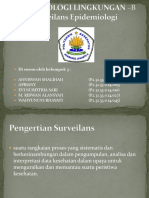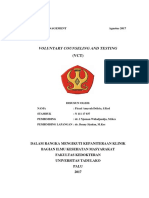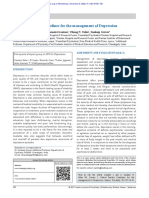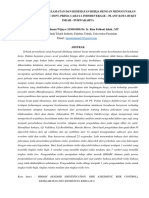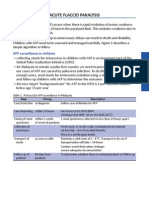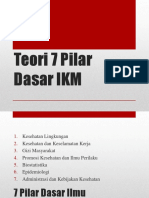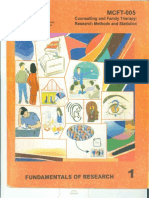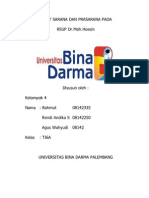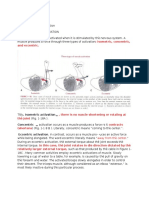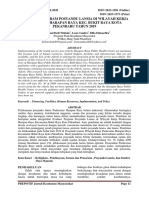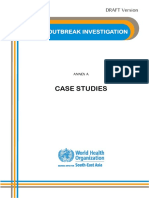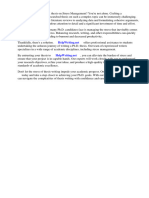Ijph 48 808 PDF
Ijph 48 808 PDF
Uploaded by
Gusti Ayu KrisnayantiCopyright:
Available Formats
Ijph 48 808 PDF
Ijph 48 808 PDF
Uploaded by
Gusti Ayu KrisnayantiOriginal Title
Copyright
Available Formats
Share this document
Did you find this document useful?
Is this content inappropriate?
Copyright:
Available Formats
Ijph 48 808 PDF
Ijph 48 808 PDF
Uploaded by
Gusti Ayu KrisnayantiCopyright:
Available Formats
Iran J Public Health, Vol. 48, No.5, May 2019, pp.
808-815 Review Article
Physical Rehabilitation Services in Disasters and Emergencies: A
Systematic Review
Ghasem MOUSAVI 1, *Ali ARDALAN 1, Hamidreza KHANKEH 2, Mohammad
KAMALI 3, Abbas OSTADTAGHIZADEH 1
1. Department of Health in Disasters and Emergencies, School of Public Health, Tehran University of Medical Sciences, Tehran, Iran
2. Research Center for Disaster Recovery, University of Social Welfare & Rehabilitation Sciences, Tehran, Iran
3. Department of Rehabilitation Basic Sciences, Rehabilitation Research Center, School of Rehabilitation Sciences, Iran University of
Medical Sciences, Tehran, Iran
*Corresponding Author: Email: aardalan@tums.ac.ir
(Received 20 Nov 2018; accepted 11 Jan 2019)
Abstract
Background: Physical rehabilitation, as one of the rehabilitation disciplines, can play a great role in humanitar-
ian reliefs. The effectiveness of physical rehabilitation services is completely dependent on time of intervention,
the importance of good timing in providing services during disasters is not well understood. The objective of
this study was to systematically review the physical rehabilitation services provided in disasters and emergen-
cies.
Methods: An electronic search of PubMed, Scopus, Cochrane, and PEDro (Physiotherapy Evidence Data-
base) was undertaken from Jan 2000 to Sep 2017. All English studies reporting physical rehabilitation services
in natural and man-made disasters were selected regardless of study design. The included studies were analyzed
by descriptive and analytical method.
Results: Thirteen studies were included after reviewing by title, abstract and full text in this study. Most of the
physical rehabilitation studies come back to recent years. Most of the disaster physical rehabilitation services
were physiotherapy and occupational therapy. The physical rehabilitation experts have been attended in the
affected area from the few first hours until several months after disasters in order to provide the required ser-
vices to the affected population.
Conclusion: There are few studies about physical rehabilitation services provided in the disaster-affected areas
and this study showed that the services were limited and at different times. Physical rehabilitation services post
disasters should have a comprehensive service model, like other health services. Therefore, it is necessary to
conduct further studies to achieve this aim.
Keywords: Physical rehabilitation; Disability; Disasters; Emergencies
Introduction
Many major health conditions need rehabilitation and maintain optimal functioning in interaction
to improve outcomes following disasters and with their environments” (4). If rehabilitation
emergencies (1-3). Rehabilitation is “a set of intervention is provided in time, they can result
measures that assist individuals who experience, in better health outcomes; reduce hospital stays
or are likely to experience disability to achieve and the probability of long term disability. Reha-
808 Available at: http://ijph.tums.ac.ir
Mousavi et al.: Physical Rehabilitation Services in Disasters and Emergencies …
bilitation includes improving an individual`s abil- derstanding of the necessary rehabilitation reliefs
ity to function and to impact his/her environ- provided in disasters (23).
ment (4). Moreover, rehabilitation includes pre- Accordingly, this study aimed to investigate the
vention of the loss of function, restoration of physical rehabilitation services provided in disas-
function and increase or maintenance of current ters and emergencies.
function (4, 5). There is a lack of data on the
global need for rehabilitation (4, 6). Rehabilita- Methods
tion has recently been recognized as an important
sector of humanitarian response (7). Some of the This study was conducted to answer this research
injured people in disasters and emergencies expe- question as follows: what are the characteristics
rience short or long-term disability due to inade- (kind of service and time of service delivery) of
quate treatment of injuries (8). Bone fractures, physical rehabilitation services in provided in past
spinal cord injuries, traumatic brain injuries, am- disasters and emergencies?
putations, peripheral nerve injuries, and burns are
common injuries in disasters and conflicts which Data sources
can lead to physical or cognitive limitation in For the purpose of this review, PubMed, Scopus,
functioning in the victims (9-12). Cochrane, and PEDro (Physiotherapy Evidence
Article 11 of the United Nations (UN) conven- Database) databases were the main sources of
tion on the rights of persons with disabilities information in this study. Since research on disas-
mandates countries to support persons with disa- ter physical rehabilitation is a relatively new con-
bility in disasters and conflicts (13). The UN cept, the time of the search was limited to Jan
convention mandates that rehabilitation interven- 2000 to Sep 2017.
tions should occur during early disaster response They were accessed and searched in Dec of 2017.
and follow months and years later at the commu- In addition, for locating gray literature, we used
nity level. Currently, rehabilitation services are different searching strategies: 1) Google search
rarely provided for victims of disasters, if they engine, 2) purposive websites, and 3) consultation
are, they tend to be not at the right time or place with national and international experts. The ref-
(14). erence lists of founded studies were other fruitful
Physical rehabilitation plays an important role in sources of material.
the rehabilitation process and it is an essential
part of fully integrating disabled people in society Search strategy
(15). Several studies have confirmed the effec- All sources of written material were obtained us-
tiveness of early rehabilitation intervention for ing the same search strategy. Terms such as phys-
treating injured people in disasters (10, 16, 17). ical rehabilitation, physiotherapy, physical thera-
Moreover, persons with preexisting disabilities py, occupational therapy, speech therapy, orthot-
can benefit from rehabilitation services in affect- ics, prosthetics, disaster, and conflict were ap-
ed areas (4, 14, 18). Many studies have reviewed plied by using Medical Subject Headings
rehabilitation services post-disasters such as Hur- (MESH). MESH terms were also used to find
ricane Katrina, the Pakistan flood, Sichuan and more relevant articles (Table 1).
Haiti earthquakes and have found that unique
Inclusion criteria
rehabilitation intervention which relied complete-
Included articles were that published in academic
ly upon researchers’ experiences and interests (16,
journals, reported one or more kinds of physical
19-21). Literature on rehabilitation reliefs in dis-
rehabilitation intervention such as physiotherapy,
asters is scarce, anecdotal (22) and is dependent
occupational therapy, speech therapy, orthotics
on the authors' field experiences. Some rehabili-
and prosthetics in natural/man-made disasters
tation experts have recommended conducting
and conflicts.
various scientific researches to gain a better un-
Available at: http://ijph.tums.ac.ir 809
Iran J Public Health, Vol. 48, No.5, May 2019, pp. 808-815
Table 1: Search strategy applied to search the databases
A) (rehabilitation) OR (“physical rehabilitation”) OR (“physical therapy”) OR (physiotherapy) OR (“occupational therapy”)
OR (“speech therapy”) OR (orthotics) OR (prosthetics)
B) (disaster) OR (earthquake) OR (conflict) OR (emergency)
C) (rehabilitation OR “physical rehabilitation” OR “physical therapy” OR physiotherapy OR “occupational therapy” OR
“speech therapy” OR orthotics OR prosthetics) AND (disaster OR earthquake OR conflict OR emergency)
Exclusion criteria documents were entered in Microsoft Excel
Excluded articles focused only on the importance Spreadsheet and duplicate titles were removed.
and effectiveness of rehabilitation services or the Finally, all articles were reviewed by the second
epidemiology of injuries of disaster and conflicts. author. In order to perform a blind-review, the
Moreover, studies with no intervention about names of authors and journals were removed (Fig.
providing rehabilitation services in disasters and 1). The reviewers applied a form to extract data
conflicts were removed from the study. Non- from selected studies. The form included: name of
English studies and studies published before the first/corresponding author, country, publica-
2000 were also excluded. tion year and type of hazard, kind and time of in-
tervention, methodology of the study and sum-
Study selection and data extraction mary of findings. Then the information of includ-
The first author reviewed titles of all articles re- ed studies and training material were categorized
trieved by searching in databases. Every article that to descriptive and thematic analysis.
met the inclusion criteria was selected. Selected
Fig. 1: Flow diagram of the articles selecting process
810 Available at: http://ijph.tums.ac.ir
Mousavi et al.: Physical Rehabilitation Services in Disasters and Emergencies …
Results during 2010-2016. One study had cohort design,
one study was with design of quasi-experimental
Totally, 2281 studies were obtained through and the two researches has been designed cross-
electronic search in databases and other re- sectional while the other nine resources were
sources. After removing duplicate articles, 2150 review of programs, experiences, clinical notes or
titles were selected for further review. By review- perspective. Most studies (69.2%) focused on
ing studies based on title and abstract, 1959 stud- providing services of physical rehabilitation after
ies were excluded from the study and three ab- the earthquake, two (15.4%) on hurricane and
stracts were not found. Full-text review excluded two (15.4%) were related to man-made disasters
170 articles while eight full texts were inaccessible including bombing attack and conflict.
for review. Altogether, 13 qualified studies were Overall, 11 of the 13 included studies (84.6%)
analyzed in this review. were physical rehabilitation relevant services in
past six major natural disasters, including Bam,
Descriptive Analysis Kashmir, Sichuan, Haiti and Nepal earthquakes
Four articles of the thirteen (31%) were affiliated and the Hurricane Katrina. Two (15.4%) studies
to China and Canada (2 articles per country), focused on physical rehabilitation service delivery
three articles were affiliated with USA (23%) and in man-made disasters. The earliest document in
the 6 other countries, including Haiti, Nether- this review was about providing physical rehabili-
lands, Iran, India, Australia and Philippines were tation services after the Bali bombing disaster
attended with one article in this study (46%). Ten 2002 that published in 2005.
articles of the thirteen (76.9%) were published
Table 2: Articles analyzed for the systematic review literature
Authors Year Study type Affiliated National/International Previously Hazard
Country providers coordinated
(Yes/NO)
Edgar D, Wood F, Goodwin- 2005 Report on Australia National Y Bombing
Walters A experience
Raissi GR, 2007 Clinical note Iran National and international N Earthquake
Bloodworth D. M., Kevorkian 2007 Review USA National N Hurricane
C. G., Rumbaut E., Chiou-Tan
F. Y.
Iezzoni L. 2010 Perspective USA International N Earthquake
Landry M, O'Connell C, Tardif 2010 Perspective Canada International N Earthquake
G, Burns A
Gorry C. 2010 International Haiti International Y Earthquake
Cooperation
Report
Li Y, Reinhardt J, Gosney J, 2012 Prospective China National N Earthquake
Zhang X, Hu X, Chen S et al cohort study
O’Connell C, Ingersoll A 2012 Report on expe- Canada National and international N Earthquake
rience
Zhang X., Reinhardt J. D., 2013 Longitudinal China National N Earthquake
Gosney J. E., Li J quasi-
experimental
Armstrong JC, Nichols BE, 2014 Review of pro- Netherlands National and international N Civil conflict
Wilson JM, Cosico RA, Shanks gram outcomes
L.
Keshkar S, Kumar R, Bharti B 2014 Cross-Sectional, India National N Earthquake
descriptive
Benigno MR, Kleinitz P, Calina 2015 Cross-Sectional, Philippines National and international N Typhoon
L, Alcido MR, Gohy B, Hall JL descriptive
Landry MD, Sheppard PS, 2016 perspective USA National and international N Earthquake
Leung K, Retis C, Salvador EC, article
Raman SR.
Available at: http://ijph.tums.ac.ir 811
Iran J Public Health, Vol. 48, No.5, May 2019, pp. 808-815
There was no publication on physical rehabilita- patible with the conditions and facilities of the
tion in disasters and emergencies in 2006. In region before occurring disaster.
2007, two articles were published, Bam earth- In addition, there is not a consensus on time of
quake 2003, and Hurricane Katrina 2005, respec- physical rehabilitation service delivery in disas-
tively. There was another gap between 2008 and ters and emergencies. In some cases such as
2009. However, in 2010 three articles were pub- bombing attack, the mentioned services have
lished in relation to the Haiti earthquake and es- been provided during hospitalization for victims,
tablishing physical rehabilitation services to while in a conflict, access to rehabilitation ser-
affected population. During 2012, 2013 and 2014, vices may postpone for several months. We ob-
two, one and two articles were published, respec- served in other studies that this time between
tively. One article was published in 2015 and one the occurring of disaster and delivery of rehabili-
article was published in 2016 (Table 2). tation services varies from medical stabilization
of the injured persons in first or two weeks to
Analytical analysis one or two months following disasters. In all
Most studies indicated the multidisciplinary physi- studies, physical rehabilitation services were es-
cal rehabilitation including physical therapy, oc- tablished by rehabilitation professionals. In the
cupational therapy and assistive devices as the Bam earthquake, first, the international provid-
provided rehabilitation services in the earthquake ers established rehabilitation services to affected
zones. Two studies focused on physical therapy as local people and then the Iranian specialists
an intervention, one study highlighted on pros- were involved in the delivery of rehabilitation
thetics delivery in humanitarian action and the services. In relation to preparedness of physical
other research was related to orthotics and physi- rehabilitation relief teams, most of these teams
otherapy. In such disasters, the physical rehabilita- that attended at the disaster scene were not pre-
tion services were established temporary in peri- viously prepared. Only, in one case the coordi-
ods of time and depended on existing cases in the nation between international organizations and
affected area. In the other disasters, the provided national service providers were organized prior
rehabilitation services completely relied on mod- to disaster. Table 3 shows the rehabilitation ser-
ern and professional equipment that was incom- vices provided in past disasters and emergencies.
Table 3: Provided physical rehabilitation services during past disasters and emergencies
Event Kind of services Time of services
Earthquake Bam (2003) Physical medicine and rehabilitation, After at least one month
physical therapy, occupational therapy,
orthotics and prosthetics
Kashmir (2005) Rehabilitation aids devices, Same time as the medical
physiotherapy and psychotherapy, Physical medicine and rehabilitation treatment services
Sichuan (2008) Physical medicine and rehabilitation, physiotherapy, Two months after
occupational therapy and traditional Chinese the event
medicine
Haiti (2010) Rehabilitation services First two weeks
Nepal (2015) rehabilitation services initial days after the earthquake
Hurricane/ Katrina
Ty- (2005) Physical medicine and rehabilitation, physical therapy, First days
phoon occupational therapy and cast-
application
Haiyan (2013) Physical medicine and rehabilitation, physical therapy and occupational ther-
during the acute response
apy up to five months
Emergency Bombing Physical therapy Hospitalization
Sri Lanka conflict Spinal cord injury After ending
rehabilitation conflict
812 Available at: http://ijph.tums.ac.ir
Mousavi et al.: Physical Rehabilitation Services in Disasters and Emergencies …
Discussion ian organizations (7, 20). In the disasters of the
past decade, rehabilitation aids have been estab-
The main aim of the study was identifying char- lished by national and international skilled or in-
acteristics of physical rehabilitation services in experienced organizations in the affected areas.
past disasters and emergencies. A number of in- This finding was stated in a pilot study conducted
cluded articles for review obviously showed that after the Haiti earthquake (25). Nearly all disaster
research related to disaster physical rehabilitation physical rehabilitation services provided by na-
was limited and interest in research on disaster tional organizations or specialists in developing
rehabilitation relief has been recently increased. countries were not predicted before (14). Most
Therefore, before 2012 research on this subject times, rehabilitation specialists have provided
was sporadic. services based on humanitarian reasons in
The few publications on disaster physical rehabil- disaster-affected areas. While optimum rehabilita-
itation are supported by some past studies (16, tion outcomes require a multidisciplinary ap-
17, 19-21). From among them, a few have pre- proach, this is not possible without organization-
sented the established characteristics of physical al responsibility (14, 26, 27). Hence, physical re-
rehabilitation in disasters or emergencies. Almost habilitation reliefs require regular and coordinat-
all the articles included in this study have been ed intervention to achieve optimal outcomes.
written by authors who themselves played a part Enough documentation does not exist on organi-
in providing the services after a disaster. zational efforts in developing disaster rehabilita-
This study showed that physical rehabilitation tion teams in national and international levels.
reliefs were conducted sporadically in past disas- Although, rehabilitation professionals have pro-
ters and emergencies. Emergencies, and that the vided services to victims in more disasters in the
services provided, especially during the early past, the services have been rarely provided by
phase, were by and large, uncoordinated. non-specialist organizations or people (14). At
Our findings confirm that physical rehabilitation present, rehabilitation resources are not able to
relief is either not provided or provided insuffi- meet rehabilitation needs, especially in the devel-
ciently during the early phases of disasters. After oping world.
the Bam earthquake, the first rehabilitation spe- Health system response to disasters requires dis-
cialists entered the earthquake zone after at least aster preparedness on three levels: prevention,
one month, and this delayed arrival was of little medical treatment and rehabilitation (28). Many
help to patients due to a lack of physical rehabili- studies have been carried out on prevention, and
tation equipment (11, 22). In the Kashmir earth- medical treatment as well as developed models of
quake, rehabilitation services were provided for service delivery for these two components (29-
the patients in the first phase at the same time as 32). However, as also indicated, no such model is
medical treatment services. In spite of the timely available in the literature regarding rehabilitation,
response, however, there were rehabilitation re- especially in the early phases (23).
lated deficiencies and a lack of necessities in the
region (19, 21). Moreover, because of poor con- Conclusion
ditions in Haiti, rehabilitation services were prob-
lematic and sporadic (18). Research on disaster physical rehabilitation is rel-
Among the different aspects of therapy, physical atively new and limited evidence exist. Moreover,
therapy and prosthetics were the most available many of the existing studies in this scope are ex-
needs for disaster and emergency victims (23, 24). perience-based. This review recommends the in-
Physical therapy is the most known in the fields tegration of physical rehabilitation interventions
of physical rehabilitation and prosthetics fabrica- into response plans of the health system at the
tion and is supported by international humanitar- time of disasters and emergencies. This issue
Available at: http://ijph.tums.ac.ir 813
Iran J Public Health, Vol. 48, No.5, May 2019, pp. 808-815
needs further studies to be able to create a com- 7. Tataryn M, Blanchet K (2012). Evaluation of
prehensive model to deliver coordinated and post-earthquake physical rehabilitation re-
appropriate services of physical rehabilitation fol- sponse in Haiti, 2010 – a systems analysis. In-
lowing disasters and emergencies, so does the ternational Center for Evidence on Disability
other healthcare models. (ICED). UK, 2012.
8. World Health Organization (2013). Guidance
Note on Disability and Emergency Risk
Ethical considerations Management for Health.
9. Gosney JE Jr (2010). Physical Medicine and Re-
Ethical issues (Including plagiarism, informed habilitation: Critical Role in Disaster Re-
consent, misconduct, data fabrication and/or fal- sponse. Disaster Med Public Health Prep,
sification, double publication and/or submission, 4(2):110-2.
redundancy, etc.) have been completely observed 10. Li J, Xiao M, Zhang X, Zhao Z (2011). Factors
by the authors. affecting functional outcome of Sichuan-
earthquake survivors with tibial shaft frac-
tures: A follow-up study. J Rehabil Med,
Acknowledgements 43(6):515-520.
11. Mohebbi HA, Mehrvarz S, Saghafinia M et al
No financial support was received for this study. (2008). Earthquake related injuries: assess-
ment of 854 victims of the 2003 Bam disaster
Conflict of interest transported to tertiary referral hospitals. Pre-
hosp Disaster Med, 23: 510–515.
The authors declare no conflicts of interest. 12. Zhang L, Li H, Carlton J, Ursano R (2009). The
injury profile after the 2008 earthquakes in
China. Injury, 40(1):84-86.
References 13. United Nations (2006). Convention on Rights of
People with Disabilities.
1. Kalra L, Dale P, Crome P (1993). Improving https://www.un.org/development/desa/disa
stroke rehabilitation. A controlled study. bilities/convention-on-the-rights-of-persons-
Stroke, 24(10):1462-1467. with-disabilities.html
2. Khan F, Baquley IJ, Cameron ID (2003). Reha- 14. Gosney J, Reinhardt J, Haig A, Li J (2011). De-
bilitation after traumatic brain injury. Med J veloping Post-Disaster Physical Rehabilita-
Aust, 178 (6): 290-295. tion: Role of the World Health Organization
3. National Health Services Clinical Advisory Liaison Sub-Committee on Rehabilitation
Groups Report (2010). Regional Networks Disaster Relief of the International Society of
for Major Trauma. Physical and Rehabilitation Medicine. J Rehabil
4. World Health Organization (2011). 2011 World Med, 43(11):965-968.
report on disability. 15. International Committee of the Red Cross
www.who.int/disabilities/world_report/2011 (2010). Physical rehabilitation programme,
/ annual report 2010.
5. Von Groote P, Bickenbach J, Gutenbrunner C 16. Li Y, Reinhardt J, Gosney J et al (2012). Evalua-
(2011). The world report on disability- tion of functional outcomes of physical reha-
Implications, perspectives and opportunities bilitation and medical complications in spinal
for physical and rehabilitation medicine cord injury victims of the Sichuan earthquake.
(PRM). J Rehabil Med, 43(10):869-75. J Rehabil Med, 44(7):534-540.
6. Maki D, Tarvydas V (2012). Rehabilitation Counsel- 17. Ni J, Reinhardt J, Zhang X et al (2013). Dysfunc-
ing: A Specialty Practice of the Counseling Profession. tion and Post-Traumatic Stress Disorder in
In: The professional practice of rehabilitation counsel- Fracture Victims 50 Months after the Sichuan
ing. Eds, Maki D, Tarvydas V. New York, Earthquake. PLoS One, 8(10):e77535.
Springer Pub, pp. 3-16. 18. Iezzoni L (2010). Disability Legacy of the Haitian
Earthquake. Ann Intern Med, 152(12):812-4.
814 Available at: http://ijph.tums.ac.ir
Mousavi et al.: Physical Rehabilitation Services in Disasters and Emergencies …
19. Ali I, Ali Mir A, Jabeen R et al (2010). Morbidity 26. Gosney J, O’Connell C (2016). Rehabilitation of
pattern and impact of rehabilitation services Disaster Casualties. In: Koenig and Schultz's Disas-
in earthquake victims of Kashmir, India. Int J ter Medicine: Comprehensive Principles & Practices.
Health Sci (Qassim), 4(1):59-67. Eds, Koenig K, Schultz C. Cambridge Uni-
20. Rathore F, Farooq F, Muzammil S et al (2008). versity Press, USA, pp. 377-388.
Spinal cord injury management and rehabilita- 27. Landry M, O'Connell C, Tardif G, Burns A
tion: highlights and shortcomings from the (2010). Post-earthquake Haiti: the critical role
2005 earthquake in Pakistan. Arch Phys Med for rehabilitation services following a humani-
Rehabil, 89(3):579-585. tarian crisis. Disabil Rehabil, 32(19):1616-1618.
21. Keshkar S, Kumar R, Bharti B (2014). Epidemi- 28. Meyer T, Gutenbrunner C, Bickenbach J et al
ology and impact of early rehabilitation of (2011). Towards a conceptual description of
spinal trauma after the 2005 earthquake in rehabilitation as a health strategy. J Rehabil
Kashmir, India. Int Orthop, 38(10):2143-2147. Med, 43(9):765-769.
22. Raissi GR (2007). Earthquake and rehabilitation 29. Snooks H, Kingston M, Anthony R, Russell I
needs: experiences from Bam, Iran. J Spinal (2013). New Models of Emergency Prehospi-
Cord Med, 30(4):369-72. tal Care That Avoid Unnecessary Conveyance
23. Nixon S, Cleaver S, Stevens M et al (2010). The to Emergency Department: Translation of
role of physical therapists in natural disasters: Research Evidence into Practice? Scientific-
what can we learn from the earthquake in WorldJournal, 2013: 182102.
Haiti? Physiother Can, 62(3):167-71. 30. Bahadori M, Saghafinia M, Teymourzadeh E,
24. Edgar D, Wood F, Goodwin-Walters A (2005). Yaghoubi M (2014). Care model factors of
Maintaining physical therapy standards in an pre-hospital emergency services in Iran. Jour-
emergency situation: Solutions after the Bali nal of Health Policy and Sustainable Health.
bombing disaster. Burns, 31(5):555-557. 1(1):27-31.
25. Rauch A, Baumberger M, Moise F et al (2011). 31. World Health Organization (2005). Prehospital
Rehabilitation needs assessment in persons trauma care systems.
with spinal cord injury following the 2010 32. Faanes E, Guggenbuehl A, Johnston E, Larsen
earthquake in Haiti: A pilot study using an K, Stien C. Experiences of physical therapists who
ICF-based tool. J Rehabil Med, 43(11):969-975. participate in disaster relief work Haiti [disserta-
tion]. St. Catherine University, USA; 2012.
Available at: http://ijph.tums.ac.ir 815
You might also like
- Health Drink QuestionnaireDocument6 pagesHealth Drink QuestionnaireChandanMatolia100% (1)
- African Textbook PsychiatryDocument13 pagesAfrican Textbook PsychiatryJagdishVankar0% (1)
- Lecture 12-National Global Psychosocial Problem-Dr. Mahar Agusno, SP - KJ (K) (2020) PDFDocument37 pagesLecture 12-National Global Psychosocial Problem-Dr. Mahar Agusno, SP - KJ (K) (2020) PDFstefany huangNo ratings yet
- Non-Reactive Research: Secondary Data & Content AnalysisDocument17 pagesNon-Reactive Research: Secondary Data & Content Analysissunit dasNo ratings yet
- 10 1016@j JHT 2017 02 001 PDFDocument10 pages10 1016@j JHT 2017 02 001 PDFGusti Ayu KrisnayantiNo ratings yet
- Duque2021 Article OsteosarcopeniaAGeriatricGiantDocument4 pagesDuque2021 Article OsteosarcopeniaAGeriatricGiantVERONICA BARRERANo ratings yet
- Hubungan Pengetahuan Dan Sikap Murid SD Terhadap Personal HygieneDocument8 pagesHubungan Pengetahuan Dan Sikap Murid SD Terhadap Personal HygieneVetri NathaliaNo ratings yet
- Mella CtsDocument34 pagesMella CtsAldo FathurrahmanNo ratings yet
- Epid B SurveilandDocument26 pagesEpid B SurveilandalansyahNo ratings yet
- Laporan Management VCTDocument20 pagesLaporan Management VCTFiryal Amyrah Delicia YusufNo ratings yet
- MANUSKRIP FKM UI FinalDocument19 pagesMANUSKRIP FKM UI FinalDemsa SimbolonNo ratings yet
- Clinical Practice Guidelines For The Management of DepressionDocument17 pagesClinical Practice Guidelines For The Management of DepressionAnamika SinhaNo ratings yet
- Program Studi Teknik Industri, Fakultas Teknik, Universitas Pasundan EmailDocument13 pagesProgram Studi Teknik Industri, Fakultas Teknik, Universitas Pasundan EmailFarid MuhamadNo ratings yet
- Rama 13201 10011181510260 0024016904 01 Front RefDocument33 pagesRama 13201 10011181510260 0024016904 01 Front RefItha Nurulmaidah Hi CangNo ratings yet
- Jurnal Bahasa InggrisDocument7 pagesJurnal Bahasa Inggrisimma lholhypopNo ratings yet
- Jurnal BPJS 4Document10 pagesJurnal BPJS 4yolla kemala munifNo ratings yet
- Anaemia Policy BriefDocument7 pagesAnaemia Policy BriefAini DjunetNo ratings yet
- CPDocument85 pagesCPSudhir MishraNo ratings yet
- 48 - Acute Flaccid ParalysisDocument2 pages48 - Acute Flaccid ParalysisMaryam HanifahNo ratings yet
- Pengaruh Sari Kurma Pada Bumil Trimester 3Document8 pagesPengaruh Sari Kurma Pada Bumil Trimester 3Ardha RimosanNo ratings yet
- The Role of Physical Medicine & Rehabilitation in LBPDocument40 pagesThe Role of Physical Medicine & Rehabilitation in LBPruriNo ratings yet
- Soccer Injuries in Children and AdolescentsDocument17 pagesSoccer Injuries in Children and AdolescentsJose Maria Lloreda100% (1)
- Teori 7 Pilar Dasar IKMDocument41 pagesTeori 7 Pilar Dasar IKMIntan Putri Wirahana ShantyNo ratings yet
- Pengaruh Pijat Bayi Terhadap Kelancaran Bab Pada Balita Usia 12-24 BulanDocument6 pagesPengaruh Pijat Bayi Terhadap Kelancaran Bab Pada Balita Usia 12-24 BulanAna SafitriNo ratings yet
- Gambaran Benigna Prostat Hiperplasia Di RSUP Prof. Dr. R. D. Kandou Manado Periode Januari 2014 - Juli 2017Document3 pagesGambaran Benigna Prostat Hiperplasia Di RSUP Prof. Dr. R. D. Kandou Manado Periode Januari 2014 - Juli 2017Gado GadoNo ratings yet
- Jurnal Kebijakan Kesehatan IndonesiaDocument5 pagesJurnal Kebijakan Kesehatan IndonesiaFitriNo ratings yet
- Indonesia Maternal Health Articles - Abstracts - NeonatalDocument92 pagesIndonesia Maternal Health Articles - Abstracts - Neonatalnova seftya aristadilaNo ratings yet
- Jurnal Biskuit Ubi Ungu Ikan SidatDocument12 pagesJurnal Biskuit Ubi Ungu Ikan SidatYayu Angriani100% (1)
- M1.U1. TutorialDocument7 pagesM1.U1. TutorialRizki DiniNo ratings yet
- Penyembuhan Luka Post Sectio Cesarea SC Dengan EksDocument8 pagesPenyembuhan Luka Post Sectio Cesarea SC Dengan Eksmarlia harniNo ratings yet
- Inisiasi Menyusui DiniDocument14 pagesInisiasi Menyusui DiniHikmahNo ratings yet
- 2009 Ostomy - Care - ManagementDocument117 pages2009 Ostomy - Care - Managementdurdane palabiyik yilmazNo ratings yet
- Calgary Blackbook 2015 2016Document349 pagesCalgary Blackbook 2015 2016Tenri Ashari100% (2)
- Sumber Data SIKDocument34 pagesSumber Data SIKandy azizNo ratings yet
- Jurnal Terbaru GiziDocument11 pagesJurnal Terbaru GiziTasarane AngelNo ratings yet
- Writing Knee OsteoarthritisDocument58 pagesWriting Knee OsteoarthritisHanani KamaludinNo ratings yet
- Penyuluhan Peran Remaja Dalam Pencegahan StuntingDocument8 pagesPenyuluhan Peran Remaja Dalam Pencegahan StuntingSalsabilaqatrm SalsaNo ratings yet
- Basic Occupational Health ServiceDocument3 pagesBasic Occupational Health ServicetheoNo ratings yet
- Block-1 Fundamentals of ResearchDocument121 pagesBlock-1 Fundamentals of ResearchRatika DanielNo ratings yet
- It Audit Sarana Dan Prasarana Rumah Sakit M HoesinDocument10 pagesIt Audit Sarana Dan Prasarana Rumah Sakit M HoesinRakaru D Sentaryu50% (2)
- ID Analisis Kesiapan Asosiasi Pengobat Tradisional Terhadap Rencana Implementasi PeDocument11 pagesID Analisis Kesiapan Asosiasi Pengobat Tradisional Terhadap Rencana Implementasi PeTpoad P-AspetriNo ratings yet
- 26 Sri Rahayu OktavianiDocument105 pages26 Sri Rahayu OktavianiRusmi YatiNo ratings yet
- Penolakan Pelayanan Medis Oleh Rumah Sakit Terhadap Pasien Yang Membutuhkan Perawatan DaruratDocument20 pagesPenolakan Pelayanan Medis Oleh Rumah Sakit Terhadap Pasien Yang Membutuhkan Perawatan DaruratDendy AbriansyahNo ratings yet
- Skripsi Full Tanpa Pembahasan PDFDocument76 pagesSkripsi Full Tanpa Pembahasan PDFJulius HabibiNo ratings yet
- Rangkuman Kinesiologi NeumannDocument19 pagesRangkuman Kinesiologi NeumannAnton HilmanNo ratings yet
- Contoh Percakapan Perawat Dan Pasien Dalam Bahasa InggrisDocument2 pagesContoh Percakapan Perawat Dan Pasien Dalam Bahasa InggrisLa Ode SamsulNo ratings yet
- Evaluasi Program Posyandu Lansia Di Wilayah Kerja Puskesmas Harapan Raya Kec. Bukit Raya Kota Pekanbaru Tahun 2019Document9 pagesEvaluasi Program Posyandu Lansia Di Wilayah Kerja Puskesmas Harapan Raya Kec. Bukit Raya Kota Pekanbaru Tahun 2019Hasan BasriNo ratings yet
- Traumatic AmputationDocument5 pagesTraumatic AmputationBayu Mario GintingNo ratings yet
- 7 Annex A Case Studies 090309Document70 pages7 Annex A Case Studies 090309komiteNo ratings yet
- Telaah Kritis Strobe - Kel - Sely, Amrina, Nurul - Epid2017Document7 pagesTelaah Kritis Strobe - Kel - Sely, Amrina, Nurul - Epid2017Selly AnggrainiNo ratings yet
- European Perinatal Health Report 2010Document252 pagesEuropean Perinatal Health Report 2010dragandragoonNo ratings yet
- Care Aktivities Dan Tingkat Hba1C Pada Pasien Dengan Diabetess Tipe 2Document21 pagesCare Aktivities Dan Tingkat Hba1C Pada Pasien Dengan Diabetess Tipe 2Yayang SavitaNo ratings yet
- Continuum of CareDocument14 pagesContinuum of CareesinelyaNo ratings yet
- Sistem Informasi KesehatanDocument29 pagesSistem Informasi KesehatanTembem Anggraeni RahmatikaNo ratings yet
- Ichas: 4 International Conference On Healthcare and Allied Sciences N SDocument5 pagesIchas: 4 International Conference On Healthcare and Allied Sciences N SyopieNo ratings yet
- Osteoarthritis KneeDocument40 pagesOsteoarthritis KneeRiddhi RanaNo ratings yet
- Effects of PNF Method For Hemiplegic Patients With Brachial Predominance After Stroke: Controlled and Blinded Clinical TrialDocument6 pagesEffects of PNF Method For Hemiplegic Patients With Brachial Predominance After Stroke: Controlled and Blinded Clinical TrialAperito InternationalNo ratings yet
- Andersen, R. M. (1995) - Revisiting The Behavioral Model and Access To Medical Care - Does It Matter-. Journal of HealthDocument11 pagesAndersen, R. M. (1995) - Revisiting The Behavioral Model and Access To Medical Care - Does It Matter-. Journal of HealthRifa FauziyyahNo ratings yet
- Who TRMDocument250 pagesWho TRMDaniel Giraldo Toro100% (1)
- Physiotherapy in Disaster Management: Physiotherapist ViewDocument3 pagesPhysiotherapy in Disaster Management: Physiotherapist ViewYulia DiniNo ratings yet
- Out 10Document13 pagesOut 10hikmat pramajatiNo ratings yet
- OT in The ICU. Revision de Mas de 200 ArticulosDocument8 pagesOT in The ICU. Revision de Mas de 200 ArticulosFlorencia Yael ItovichNo ratings yet
- Nurses RoleDocument14 pagesNurses RolesweetpeaNo ratings yet
- LBP 1 PDFDocument10 pagesLBP 1 PDFGusti Ayu KrisnayantiNo ratings yet
- ptrs009 03 03 PDFDocument6 pagesptrs009 03 03 PDFGusti Ayu KrisnayantiNo ratings yet
- J Burns 2019 07 037 PDFDocument8 pagesJ Burns 2019 07 037 PDFGusti Ayu KrisnayantiNo ratings yet
- What Is A Drug?: Kaumaram Sushila International Residential School Grade:-9 Igcse Sub: - Biology CHAPTER: - Drugs NotesDocument12 pagesWhat Is A Drug?: Kaumaram Sushila International Residential School Grade:-9 Igcse Sub: - Biology CHAPTER: - Drugs NotesAkil BabujiNo ratings yet
- Stress Management PHD Thesis PDFDocument8 pagesStress Management PHD Thesis PDFCheapPaperWritingServiceCanada100% (2)
- Amro Azrak GR 43 Case HistoryDocument9 pagesAmro Azrak GR 43 Case HistoryAmro AzrakNo ratings yet
- 13.0 - Violence in The Workplace v3.0 EnglishDocument16 pages13.0 - Violence in The Workplace v3.0 Englishkhalid_ghafoor6226No ratings yet
- Cervical Radiculopathy Nice GuidelinesDocument3 pagesCervical Radiculopathy Nice Guidelinesapi-237061134No ratings yet
- The Terror of Pediatric MedicineDocument360 pagesThe Terror of Pediatric MedicineNasir Khan100% (2)
- Ads 460 Oyo Hotel AssignmentDocument21 pagesAds 460 Oyo Hotel AssignmentIzreenNo ratings yet
- Stress ManagementDocument77 pagesStress Managementhr14100% (3)
- Managing The School System ReportDocument3 pagesManaging The School System ReportCha Carreon MarcosNo ratings yet
- Developmental, Intellectual disability-CMaraffa PDFDocument104 pagesDevelopmental, Intellectual disability-CMaraffa PDFSajid AhmadNo ratings yet
- Mamo GramDocument1 pageMamo GramtaniamarqueslawNo ratings yet
- Dr. Blyden: Urinary Tract Infection (Uti)Document24 pagesDr. Blyden: Urinary Tract Infection (Uti)Blyden NoahNo ratings yet
- Curvas Fenton PDFDocument1 pageCurvas Fenton PDFCecilia SepulvedaNo ratings yet
- 1-In A Cashless Society, People Use More Credit Cards. What Are The Advantages and Disadvantages of This Phenomenon?Document33 pages1-In A Cashless Society, People Use More Credit Cards. What Are The Advantages and Disadvantages of This Phenomenon?Jose ChavezNo ratings yet
- PL Toolboxtalk ClosedcontainerDocument1 pagePL Toolboxtalk ClosedcontainerRomanuSNo ratings yet
- 73 77 The Nursing BibleDocument129 pages73 77 The Nursing BibleChrisana Lawrence100% (2)
- DRUG STUDY-Mam CarulloDocument1 pageDRUG STUDY-Mam CarulloJorelyn Frias83% (6)
- SBAR ReferenceDocument16 pagesSBAR ReferenceTni JolieNo ratings yet
- No School AloneDocument69 pagesNo School AloneFernanda FreitasNo ratings yet
- Lecture Notes in Computer Science 4744: Editorial BoardDocument327 pagesLecture Notes in Computer Science 4744: Editorial BoardErika Biddle-StavrakosNo ratings yet
- Handbook For CaregiversDocument65 pagesHandbook For CaregiversJudy Eshom FoxleyNo ratings yet
- A Spanish Version of The Geriatric Depression Scale Mexican AmericansDocument6 pagesA Spanish Version of The Geriatric Depression Scale Mexican AmericansThamara Tapia-MunozNo ratings yet
- Case Study HypertensionDocument7 pagesCase Study Hypertensionsanthyakunjumon75% (4)
- Osteoporosis Dan Faktor Risikonya Pada Lansia Etnis JawaDocument11 pagesOsteoporosis Dan Faktor Risikonya Pada Lansia Etnis JawaH14Fadhila Alifa GhazaniNo ratings yet
- Requirements Before Issuance of Sanitary Permit: For Food EstablishmentsDocument4 pagesRequirements Before Issuance of Sanitary Permit: For Food EstablishmentsJawahir GomezNo ratings yet
- Amoeborid CapsuleDocument3 pagesAmoeborid Capsulehk_scribdNo ratings yet
- A Case Series of Ocular Manifestations in TuberculosisDocument4 pagesA Case Series of Ocular Manifestations in TuberculosisInternational Journal of Innovative Science and Research TechnologyNo ratings yet
- Application Form: Send This Form ToDocument2 pagesApplication Form: Send This Form ToKlaudia KonyaNo ratings yet








